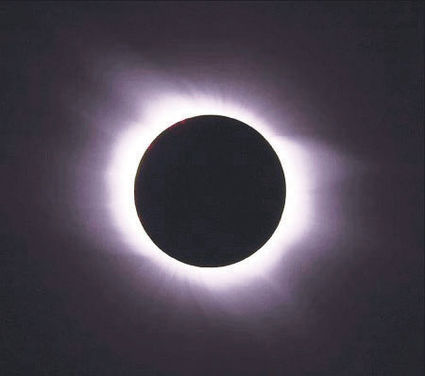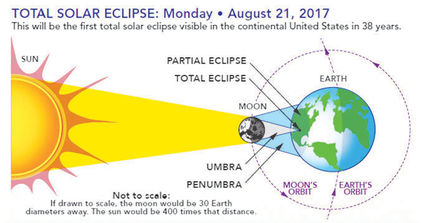Total Solar Eclipse and other astronomical events
Sky Watch - Keeping an eye above the horizon!

NASA/The Exploratorium
This image of the 2008 total solar eclipse clearly shows the sun's halo-like atmosphere, the corona.
Most of you have heard about the unusual total solar eclipse that is about to cross America on August 21st. From what I've heard, there's a great deal of misunderstanding out there. Many are confusing it with a lunar eclipse, believing it will last all day and/or that it can be seen well from Tehachapi. Let me tell you what's really going to happen.
First of all, let's talk about eclipses. An eclipse occurs when one celestial body passes in front of another. It can be one of Jupiter's moons passing in front of or behind the planet, or our moon passing in front of a star.
Solar and lunar eclipses occur when the earth or the moon pass in front of the sun. It just so happens that (at the moment) the sun and the moon appear to be very nearly the same size in our sky. Therefore, our shadows cover each other in very dramatic, but different, ways.
When the moon passes through the earth's shadow, we have a lunar eclipse in which the earth cuts off sun's light. All that reaches the moon is the combined light of all of earth's sunsets, resulting in a blood-red moon that can be seen from the entire dark side of our world.
A solar eclipse occurs when the moon passes in front of the sun. This results in a shadow cone that intersects with a relatively small swath of the earth – say, 100 km. – and moves along with the rotation of the earth combined with the revolution of the moon at say, 3000 kph (1900 mph); not unlike a very straight-moving (and very large) tornado.
One of the most frequent questions is whether you can see the Great American Solar Eclipse from Tehachapi. Well, yes and no. The moon will partially block up to about 80% of the sun. There should be a noticeable darkening as we approach 10 a.m. Using the proper precautions (filters or projection), you will be able to see the moon take a big chunk out of the sun.
The relatively small path of totality, where the moon completely covers the sun, will sweep in from the Pacific Ocean on the Oregon coast, then pass through the states of Idaho, Wyoming, Nebraska, Kansas, Missouri, Illinois, Kentucky, Tennessee, Georgia, and South Carolina, before heading out across the Atlantic Ocean.
Communities along this path have been gearing up for this phenomenon for many months. Casper, Wyoming, will be stormed by the Astronomical League. Many of my friends have well laid plans to intercept this path, most rolling it into other vacation plans. In my case, my mother just happens to live in the path of totality in Chillicothe, Missouri!
What makes solar eclipses so fascinating – and scientifically important – is that having the moon perfectly block the light from the sun's surface (the photosphere) makes it possible to see it's atmosphere – the corona. There's much we still don't fully understand about the corona, starting with, 'Why is the corona several millions of degrees in temperature, while the sun's surface is only a few thousand?'
Much of the excitement this time stems from this being the first solar eclipse to cross the entire contiguous United States since 1918 – nearly a century. Lunar eclipses occur relatively frequently; we enjoyed quite a string of them over the last few years. However, this is my first opportunity to enjoy a total solar eclipse. The next American solar eclipse will be in 2024. However, its path will only stretch from Texas to New England (as well as central Mexico).
As with most other eclipse opportunities in my life, most of you have to work or are otherwise unable to travel to the thin ribbon of totality up north. Despite that, you can still join in the wonder and grandeur of this celestial event. eclipse2017.nasa.gov is your gateway to a host of information, educational activities, and remote participation tools. The eclipse-megacast webpage provides unique broadcast coverage from multiple locations. Indeed, because of NASA's Internet coverage and the ubiquity of Internet access, this may be the first solar eclipse that can be enjoyed by the entire free world!
There are plenty of other fine websites out there covering the eclipse, as well. So, even if you can't make the trip up north, you can still join in the spectacle.
Star parties
While the moon's shadow may not pass directly over Tehachapi this year, we have a marvelous night sky whenever the moon and weather are favorable (at least out away from the city lights). The Antelope Valley Astronomy Club, Greater Tehachapi Astronomers, Tehachapi Society of Pilots, Tehachapi Valley Recreation and Parks District, City of Tehachapi, and your local NASA/JPL Solar System Ambassadors invite you to two annual community star parties.
The first will be at Brite Lake on the Saturday night of July 22, Antelope Valley Astronomy Club's annual Star-B-Que. Activities begin at 6 p.m. and continue until dawn.
The second will be the third annual Star Party at the Tehachapi Airport on Saturday night, September 21. Local astronomers can bring their telescopes out to Aviator Park to share with the experienced and the novice alike. The Tehachapi Society of Pilots will ensure that several aircraft are on hand, as well. Activities begin at 6 p.m. and continue until 10 (it will be dark a lot earlier by then).
Almanac
Jupiter will still rule the evening sky through July, although it will be substantially lower by month's end. The 'King of the Planets' reaches quadrature, the point where it forms a right angle with the earth and the sun, on July 6th. At this point, Jupiter's shadow is extended farthest to the side, allowing us to see its moons wink in and out of view as they enter and exit Jupiter's shadow. Keen eyes can see this happen with high-end binoculars. However, any small telescope will do. Astronomy magazines have the timings of satellite shadow activity.
Saturn can be found in the evening twilight, now. By summer's end, it will relieve Jupiter as the most prominent evening planet. The rings are still tilted near their maximum "showoff angle" of 26 degrees.
Brilliant Venus continues to light up the pre-dawn sky, where she'll be for most of the rest of the year.
The long-lasting Delta Aquarid Meteor Shower peaks on the morning of July 27. Although it's a weak shower, we're far enough south to have a decent view. The Delta Aquarids are one of several weak summer showers, so keep an eye above the horizon all season.
The earth reaches aphelion, its farthest point from the sun, on July 3rd. It's fortunate for us that we're farthest from the sun right at the start of summer. This has a substantial moderating effect on our weather. Conversely, we're closer to the sun at the start of winter by about 5 million km. (3 million miles), making winter a bit more balmy. Also conversely, the southern hemisphere gets it in the eye with colder winters and hotter summers. They're really worried about global warming!
Sunrise/Sunset: 5:43 a.m./8:12 p.m. (July 1)
Full moon: July 8
New moon: July 23

NASA
We are blessed with an unusual geometry that allows us to view the atmosphere of our home star without leaving the ground. In fact, this is temporary; the moon continues to slowly move away from us at the rate of 4 cm. (1.6 in.) per year. This is also lengthening our day by about 20 microseconds per year.
A personal note
Many of you have noted that my number of articles per year has been in decline. That's because it's getting increasingly difficult for me to use the computer because of medical issues with my hands, as well as my back and neck. Also, spending long periods in front of the computer screen is now causing headaches. Although I certainly enjoy the process and results of writing, life's changes dictate that I now spend more time in my gardens and less time in front of my keyboard.
I plan to continue to write about key aerospace happenings several times a year. (I still want to maintain my typing skills!) However, a wise man listens to his body if he wants to keep it going!
I must thank Claudia White and her staff [of The Loop newspaper] for their understanding as I get older. I'm grateful to know that I can count on them graciously making space for my articles whenever I can manage it.
They're a great team with a lot of heart!




